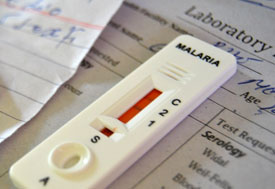Resistance to malaria drugs is a growing concern
September / October 2012 | Volume 11, Issue 5
There are ominous signs that drug-resistant malaria is emerging on the Thai-Cambodian border, scientists report. If this trend continues to spread and intensify, millions of people will have no malaria treatment options left.

Photo by Cameron Taylor/Photoshare
This startling prospect prompted Fogarty and the NIH's National Institute of Allergy and Infectious Diseases (NIAID) to convene the world's experts to examine the problem, identify possible approaches, spark collaborations and spur the field to take action.
A meeting report, published recently in the American Journal of Tropical Medicine and Hygiene, details the stakeholders' discussions about the causes of drug resistance and suggestions for combating them. The widespread use of monotherapies - malaria drugs in which artemisinin is the only active ingredient - together with the prevalence of poor-quality, including fake, malaria drugs are the main culprits, they agreed. Participants identified several priorities for action, including robust surveillance of resistance, modeling to enable emergency planning if resistance becomes widespread, advocacy to improve drug quality and discourage use of monotherapies, improved mosquito control and ongoing research to produce new antimalarials.
That the Plasmodium falciparum parasite, which transmits malaria, would find a way to survive artemisinin treatment, as it has other antimalarials, was feared from the start. The drug delivers a powerful but short-lived punch, so to kill lingering parasites it must be combined with other compounds. In 2006, the WHO recommended that artemisinin monotherapy be eliminated.
"Although some countries have enforced the ban, many pharmaceutical companies continue to produce and distribute a variety of artemisinin monotherapies to malarious countries with few regulatory obstacles," the scientists wrote in their review.
Research needed to address
artemisinin resistance
- Discover the mechanisms of artemisinin
action and parasite resistance.
- Conduct in vivo parasite clearance
studies for monitoring and surveillance.
- Develop new antimalarial drug response
assays.
- Discover molecular markers for resistance.
- Create low-cost rapid tests to measure
drug quality.
- Discover treatments that kill artemisinin-
resistant parasites and block transmission
to mosquitoes.
- Discover new partner drugs for combination
with artemisinins to treat malaria.
- Build models to estimate impact of
artemisinin resistance spread to aid
emergency response planning.
Stakeholders at the conference discussed several hurdles to keeping artemisinin effective. First, detecting resistance is no easy matter. Tests typically measure how much parasite remains in the blood 72 hours after treatment begins but do not always take into account differences in initial densities, the presence of acquired immunity, the microscopist's skill and contributions from other antimalarial drugs. Although seven-day tests are more accurate, patients have already embarked on standard treatments by then, potentially facilitating the growth of resistant parasites.
Researchers have not established exactly how artemisinin kills P. falciparum and how resistance builds. Mounting data suggest that a fraction of the parasites enter a dormant state when exposed to the drug; these survive and eventually replicate. Molecular markers being developed should facilitate large-scale surveillance to pinpoint where resistance is building and also give important insight into the mechanisms of artemisinin drug action and resistance. Genomic studies have identified candidate genes involved and further investigations will likely throw light on the parasite's interactions with artemisinin and other antimalarials.
In another approach, researchers in more than 50 projects are investigating compounds that might work against malaria where other drugs fail. Yet, any promising candidates will need years of testing for safety and efficacy before they can be delivered to clinics, the authors write.
Conference participants urged the use of mathematical modeling to identify where policymakers should require malaria control and elimination actions. They also said it's imperative to tackle the high prevalence of substandard and counterfeit antimalarials, along with stopping the continued illegal sale of monotherapies, both of which undermine artemisinin's effectiveness.
"Advocacy efforts to improve awareness and funding are needed to support the long- and short-term goals of malaria elimination so that this vital enterprise can continue unabated," the scientists stated.
More Information
To view Adobe PDF files,
download current, free accessible plug-ins from Adobe's website.